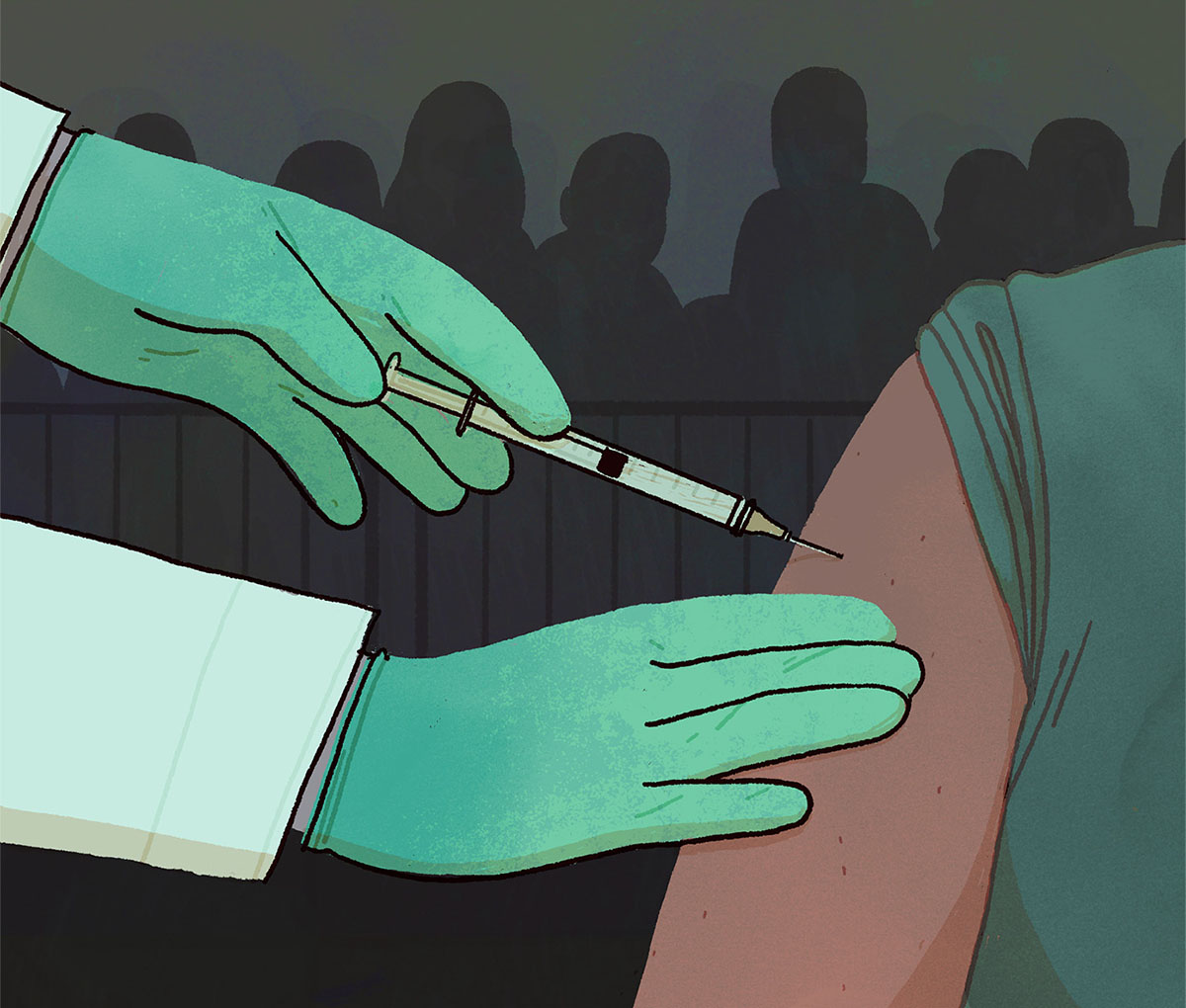
On May 5, the World Health Organization (WHO) announced it no longer considers COVID-19 a global health emergency. That doesn’t mean the pandemic is over. With the virus continuing to spread and new variants breaking out, it’s widely accepted that the disease is probably here to stay. Among other public health measures, vaccines are key to allowing us to potentially live with it as an endemic disease. But evenly distributing them has proven trickier than perhaps it should be.
As of February, about 83 percent of people in upper-middle-income countries have received at least one dose of a COVID-19 vaccine, compared with a little over a quarter of the population in low-income countries—partially because pharmaceutical companies, including Pfizer and Moderna, sold the majority of their vaccines to rich countries earlier in the pandemic. The consequences have been devastating: according to a March 2022 Oxfam report, for every life lost due to COVID-19 in a rich country, another four people died in poorer nations.
In a highly connected and globalized world, the best way to contain a pandemic is to control it in every country. “If the virus is anywhere, it’s everywhere,” says Alan Bernstein, former president and CEO of the Canadian Institute for Advanced Research and a member of Canada’s COVID-19 Vaccine Task Force. Low vaccination rates in some regions may have supported the worldwide proliferation of SARS-CoV-2 variants, including Omicron. A study published last fall in the journal Nature Medicine calculated that if vaccines had been proportionally distributed at the start of 2021, based on the size of each country’s unvaccinated population, an estimated 1.3 million lives would have been saved worldwide by the end of that year.
Inequity is ingrained in the economic and political systems under which vaccines are made and distributed. For a country to have enough vaccines for its population without relying on donations, it must be able to develop and manufacture its own or have the money to buy them. If there is to be any hope of better weathering future pandemics, the way countries produce and procure vaccines needs to change radically. The good news is we already know how to do that.
Few countries have the industry, infrastructure, manufacturing capacity, and technical know-how to produce vaccines from start to finish. Canada has limited vaccine-making capabilities despite having a strong biotechnology research community, a legacy of its research and scientific expertise dating back to the early twentieth century. At the time, the country was at the forefront of the vaccine industry, in part thanks to Connaught Laboratories. Founded as the Antitoxin Laboratory in 1914 at the University of Toronto, the facility started producing vaccines for diphtheria and tetanus in the 1920s, typhus during the Second World War, and polio in the 1950s. But a combination of factors, including changes in Connaught’s ownership and shifts in the vaccine market, severely restricted the country’s production capabilities. Connaught was sold in 1972 to the Canada Development Corporation, a Crown corporation designed to promote Canadian business, and was then completely privatized a few years later under prime minister Brian Mulroney’s government. It now operates under French multinational Sanofi.
“For decades, we neglected to rebuild our vaccine-manufacturing capacity,” says Bernstein. During the scramble for COVID-19 vaccines, Canadians had to wait. Vaccination campaigns in countries with larger markets and greater domestic production capabilities, including the United States and the United Kingdom, sped ahead, while rollout in Canada was painfully slow. But our deep pockets meant that we were still near the front of the line.
Countries in the Global South, such as South Africa, Argentina, and Uganda, were pushed to the back. In April 2020, three premier global health organizations partnered with UNICEF to launch COVAX, a joint venture intended as an antidote to vaccine inequity. The plan was for countries to pool money into the program, which would then negotiate with pharmaceutical companies to secure doses for all participating nations. This would allow COVAX to act as a global distribution warehouse, allocating vaccines where needed and shipping them to rich and poor countries simultaneously. The reality was far from it.
Spearheaded by Gavi, a Geneva-based vaccine funder backed by the Bill and Melinda Gates Foundation, along with the Coalition for Epidemic Preparedness Innovations, another Gates-funded nonprofit, and the WHO, COVAX bought vaccines from companies at negotiated prices and provided them to lower-income countries for free. But the program faced hurdles at a scale Gavi had never encountered previously.
“Gavi never challenges the monopoly,” says Varsha Gandikota-Nellutla, policy coordinator at Progressive International, a coalition of advocacy groups, political parties, publications, and research centres that launched in May 2020 and has been campaigning for equitable access to vaccines. “It’s never really had to account for this problem of everyone wanting scarce resources at the same time.” By mid-2021, only seven vaccine makers had received approval from the WHO, and a perceived hierarchy soon emerged. Initial reports of rare side effects from the AstraZeneca and Janssen vaccines led to public hesitancy, increasing demand for the limited supplies of the rest. Many lower-income countries purchased doses of the Sinopharm and Corona-Vac vaccines, both of which are developed in China. Some studies have suggested they may provide less effective long-term protection against serious illness when compared with mRNA vaccines such as Pfizer-BioNTech’s or Moderna’s.
Some rich nations, including Canada, undermined COVAX by putting money into it but then pursuing separate bilateral negotiations with pharmaceutical companies to get their vaccines first. In early 2021, Canada was poised to take 1.9 million doses of the AstraZeneca vaccine from COVAX by the middle of that year. According to the Guardian, by the end of January, Canada had already secured agreements with several companies for about 362 million doses. That fall, analytics firm Airfinity estimated that Canada, the US, the UK, the European Union, and Japan would have a cumulative 1.2 billion surplus shots by the end of the year. A June 2022 report by Oxfam and the People’s Vaccine Alliance, an international group committed to ensuring vaccine access, found that just under half of the donations those same governments had promised to lower-income countries had been delivered. The report called Canada one of the “worst offenders,” as it had delivered only about 15.4 million doses by June, even though, according to data from Doctors Without Borders, it had promised 50.7 million by the end of the year. Such shortfalls contributed to delaying vaccinations in lower-income countries: by the time 20 percent of the UK’s population had received their first dose, for example, says Gandikota-Nellutla, “not a single dose had gone out through COVAX to anywhere else in the world.”
“This charity approach was exactly what we were trying to avoid,” says Diana Sarosi, director of policy and campaigns for Oxfam Canada. At times, the donated vaccines were close to expiry or were considered by some countries to be less desirable. In Europe and North America, some governments began to pause or completely stop the use of AstraZeneca vaccines in 2021, says Fatima Hassan, a human rights lawyer and director of the Cape Town–based nonprofit Health Justice Initiative, but some countries continued to donate AstraZeneca doses to the rest of the world. “Why do we have to choose different vaccines to what’s being rolled out in Canada or the US?”
At the same time, some countries with domestic manufacturing capabilities were prevented from producing their own vaccines, in part by intellectual property restrictions. Vaccines are complicated pieces of technology that can involve multiple patents; Moderna, for example, has hundreds of mRNA vaccine–related patents issued in several countries. In October 2020, even before the WHO approved the first COVID-19 vaccine for emergency use, India and South Africa co-petitioned the World Trade Organization (WTO) to grant member nations a temporary waiver so that they could choose not to enforce certain intellectual property rights connected to the prevention, containment, and treatment of COVID-19. This would give countries permission to produce generic vaccines domestically without fear of lawsuits from pharmaceutical companies. (The question of who owns the rights to vaccine technology is complicated; in August 2022, Moderna sued Pfizer and BioNTech for alleged infringement of its mRNA-technology patents.)
Over a hundred governments, mostly of low- and middle-income countries, supported the waiver, but discussions were stalled due to opposition from the EU and some high-income nations, including the UK. Opponents of the petition argued that waiving IP rights alone would not automatically speed up the production of vaccines, as pharmaceutical companies would still have to share their technology and scientific know-how with potential manufacturers. A waiver, they added, might also disincentivize companies from future investment in research and development and hinder pharmaceutical innovation.
In June 2022, the WTO passed a watered-down version of the original proposal that did not extend to companies’ proprietary information or technical know-how. The waiver also did not cover COVID-19 testing kits or treatments. “In the end, it was very anticlimactic,” says Sarosi, who advocated for the waiver. “It was so late at that point that it almost didn’t matter anymore.”
Uneven vaccine distribution has shaped the arc of other recent disease outbreaks. Take, for example, mpox (formerly known as monkeypox), which has spread to over 100 countries since the start of 2022. When the outbreak began, Imvamune, which is one of three main smallpox vaccines being used to offer protection against the mpox virus, was already available. In press conferences last July, the WHO estimated that roughly 16 million doses had been produced by the vaccine’s sole manufacturer, Denmark-based Bavarian Nordic. But most of these were held by or promised to high-income countries. As of early February this year, there were still no vaccines available in Central and West Africa, where the mpox virus had become endemic after being first identified in humans in 1970. A call from advocacy groups for Bavarian Nordic to share vaccine know-how and for manufacturers around the world to help fill and package bulk doses has so far largely gone unanswered.
Things are starting to change. Less than 1 percent of all vaccines used in Africa are produced on the continent, but there has been a concerted push over the past few years toward increasing regional capacity. In June 2021, the first COVID-19 mRNA vaccine technology transfer hub was established in South Africa. The project brings together the WHO and its collaborators, as well as industry partners, universities, and the Africa Centres for Disease Control and Prevention, with the goal of training and licensing manufacturers from low- and middle-income countries to implement the new technology and enable local production. The hub created its own version of the mRNA COVID-19 vaccine in early 2022.
Canada, too, is looking to ease its reliance on foreign sources of vaccines. In the summer of 2021, the federal government announced an investment of more than $2.2 billion over seven years to go toward initiatives in the bio-manufacturing and life sciences industry.
Bernstein welcomes the wide-ranging investment. But, in his view, a public health emergency response shouldn’t be left solely to private pharmaceutical companies. He envisions a national vaccine facility which brings together research from Canadian universities, expertise from biopharmaceutical companies, and infrastructure to produce enough vaccines for every Canadian and also to export doses to countries that cannot manufacture their own. The facility could be used by the private sector during normal times, he says, but during a crisis, it would be commandeered by the federal government for large-scale vaccine deployment.
“We don’t wait for a fire to have a fire department,” says Bernstein. But pandemic preparedness isn’t just about having the means to fight a virus; countries have to come together to extinguish it everywhere. “You can’t put a fire half out,” he says. “It’s either out or not.”
This article was produced in partnership with the Global Reporting Centre, with funding from the National Institute for Health Care Management. Amelia Williams contributed reporting.
Follow the Money
Billions of dollars have been spent over the past three years to develop COVID-19 vaccines. Who are the real winners? Test your knowledge with this quiz.
While pharmaceutical companies haven’t publicly shared how much they’ve invested in COVID-19 vaccine research to date, estimates suggest government funding exceeded private funding for early vaccine development.
The correct answer is: Governments
While pharmaceutical companies haven’t publicly shared how much they’ve invested in COVID-19 vaccine research to date, estimates suggest government funding exceeded private funding for early vaccine development.
Governments footed a big chunk of the bill for developing early COVID-19 vaccines, but pharmaceutical companies own vaccine technology.
The correct answer is: Corporations
Governments footed a big chunk of the bill for developing early COVID-19 vaccines, but pharmaceutical companies own vaccine technology.
According to a 2021 report from the American nonprofit Public Citizen, if regional hubs were established globally, the vaccines produced by Pfizer-BioNTech and Moderna could be manufactured for as little as $1.18 and $2.85 (US) a dose respectively. In June 2022, the US signed a supply contract with Pfizer and BioNTech for about $30.48 (US) per dose—up from $24 the previous year and $19.50 in July 2020, according to Fierce Pharma. In late 2022, Pfizer announced it would sell its vaccine commercially at $110 to $130 (US) per dose when the federal government ends its purchase program.
The correct answer is: <$5 (US)
According to a 2021 report from the American nonprofit Public Citizen, if regional hubs were established globally, the vaccines produced by Pfizer-BioNTech and Moderna could be manufactured for as little as $1.18 and $2.85 (US) a dose respectively. In June 2022, the US signed a supply contract with Pfizer and BioNTech for about $30.48 (US) per dose—up from $24 the previous year and $19.50 in July 2020, according to Fierce Pharma. In late 2022, Pfizer announced it would sell its vaccine commercially at $110 to $130 (US) per dose when the federal government ends its purchase program.
According to estimates from Airfinity, almost a quarter of the over 13 billion vaccine doses administered in the world are from Pfizer-BioNTech, followed by AstraZeneca, doses of which have mostly been sent to low- and middle-income countries. Compared with others, AstraZeneca’s vaccine is believed to have saved the greatest number of lives in the first year of global vaccine rollout.
The correct answer is: Pfizer-BioNTech
According to estimates from Airfinity, almost a quarter of the over 13 billion vaccine doses administered in the world are from Pfizer-BioNTech, followed by AstraZeneca, doses of which have mostly been sent to low- and middle-income countries. Compared with others, AstraZeneca’s vaccine is believed to have saved the greatest number of lives in the first year of global vaccine rollout.
According to data from the Duke Global Health Innovation Center, as of last June, Canada had bought enough COVID-19 vaccines for about 10.76 doses per person. The United Kingdom had purchased about seven doses per person. The United States and Israel had each ordered about five doses per person.
The correct answer is: Canada
According to data from the Duke Global Health Innovation Center, as of last June, Canada had bought enough COVID-19 vaccines for about 10.76 doses per person. The United Kingdom had purchased about seven doses per person. The United States and Israel had each ordered about five doses per person.











